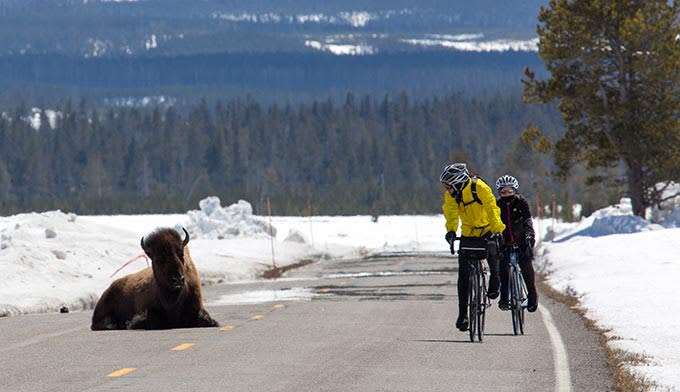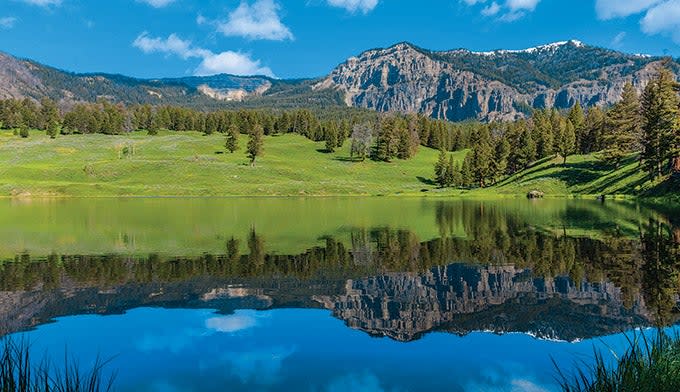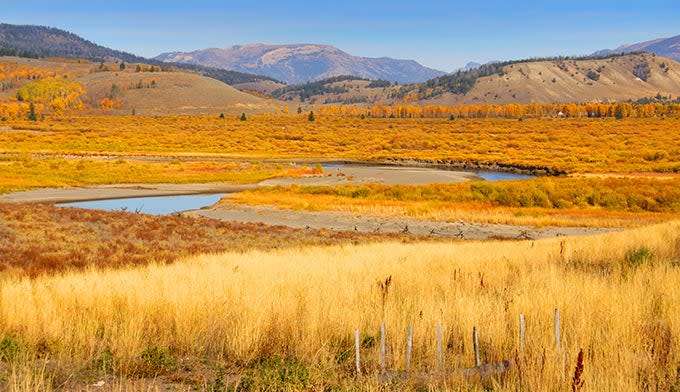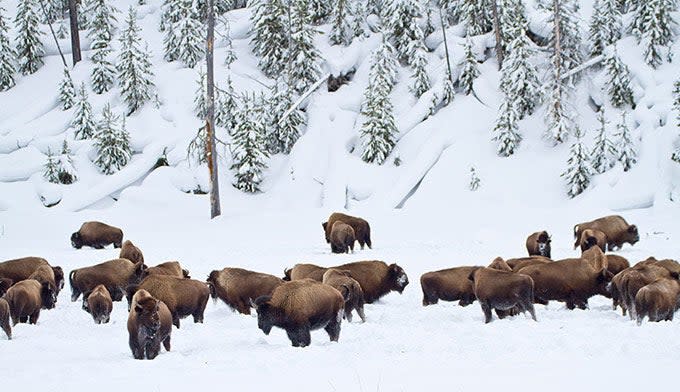Yellowstone Weather by Season
This article originally appeared on My Yellowstone Park
We recommend you pack for all seasons, even in the summer months. Nights can get below freezing and days can get chilly, especially during and after a rainstorm. Be sure to include a winter jacket, pants and shorts, a wool sweater and mittens, no matter what time of year you'll be touring the Yellowstone region. You know the saying - better safe than sorry.
It's exciting to listen to a geyser gurgle and sigh on a misty morning, or to watch a bull elk bugle under soft falling snow. In fact, any of the seasons are a glorious time to tour Yellowstone.
Yellowstone Weather In the Spring

In spring, snow is still melting from Yellowstone's mountains, forests and valleys. Yellowstone Lake is often frozen over until sometime in July. It can snow on you, hail on you or just be downright cold. But spring can be a good time to visit Yellowstone because the crowds are few and there are wild animal babies everywhere.
However, a lot of the park shuts down in the spring and so you may not have the hotel, restaurants and road access you would if you visited in summer. Because of this, you definitely want to check hotel, road and restaurant statuses before you head there. Furthermore, spring weather in Yellowstone is like winter in a lot of other places. You can have freezing temperatures, snow and sleet. If you’re imagining Yellowstone covered in wildflowers in spring, you will want to rethink visiting the park in spring. Pack your down jacket, winter hat, warm socks, along with shorts and t-shirts. Wildflowers don’t start to bloom in Yellowstone until way into June and July.
Come April and May, visitors will enjoy sights of baby bison wobbling around on their frail legs, and elk calves can be seen trying to keep up with their mothers. Bear cubs and wolf pups are also entering the world in spring and can sometimes be viewed from a far distance.
Spring can be a good time to view wolves and grizzly bears in Lamar Valley, as well. Grizzlies, still hungry from their long winter snooze, are wandering around looking for winter killed ungulates and easy prey - elk or bison calves. Lamar Valley is a large expanse of land where lots of prey can be had by hungry grizzlies, black bears, wolves and coyotes.
Because much of the backcountry is still covered with snow, hiking in some areas is limited during spring.
Average Yellowstone Weather in Spring
Month | High | Low | Precipitation | Snow Fall |
March | 37 F | 10 F | 1.1 in | 13.1 in |
April | 46 F | 20 F | 1.2 in | 5.9 in |
May | 58 F | 29 F | 2.0 in | 1.5 in |
Yellowstone Weather In Summer

The crowds are larger in summer, but Yellowstone is so big, visitors will still enjoy tremendous sights of animals, geysers and mountain vistas.
Weather is most dependable during summer, although it's been known to snow lightly in June in the park's higher elevations. Always come prepared for all four seasons, even in summer.
All park roads and facilities are open during the summer months, although the season for activities such as rafting and guided hiking trips typically start in mid to late June.
Average Yellowstone Summer Weather
Month | High | Low | Precipitation | Snowfall |
June | 68 F | 36 F | 1.5 in | 0.1 in |
July | 78 F | 41 F | 1.5 in | 0.0 in |
August | 76 F | 39 F | 1.4 in | 0.0 in |
Yellowstone Weather In Fall

During fall in Yellowstone, visitors can enjoy everything that they would enjoy in summer, but it begins to get colder and darker earlier in the day.
Fall is a great time of year to visit because the summer crowds are gone and many of Yellowstone's hoofed animals are in the "rut," a time that is marked by bugling, grunting, and other interesting behaviors that only occur in the fall.
At the end of October and into November, the snow begins to fall and roads and facilities close for the season. Yellowstone’s North Entrance is at the lowest elevation with the warmest weather conditions allowing it to be the only entrance that is open year-round.
Average Yellowstone Weather in Fall
Month | High | Low | Precipitation | Snowfall |
September | 64 F | 30 F | 1.3 in | 0.5 in |
October | 51 F | 22 F | 1.0 in | 3.7 in |
November | 34 F | 12 F | 1.0 in | 9.0 in |
Yellowstone Weather In Winter

With an average snowfall of 72 inches in December, it’s no wonder that the park cannot keep the roads clear, so the majority of roads are closed during the winter weather season. Only the road from Gardiner, Mont., to Cooke City, Mont., is open to private vehicles during the winter.
As a result, visitors during the winter get the special treat of traveling in Yellowstone via snowmobile or snowcoach into the park, or may take a ski or snowshoe tour of a specific region. We suggest to take advantage of this quiet season to get uncrowded views of geysers and frozen waterfalls.
Average Yellowstone Winter Weather
Month | High | Low | Precipitation | Snowfall |
December | 24 F | 2 F | 15.4 in | 72.1 in |
January | 24 F | 1 F | 1.1 in | 14.5 in |
February | 30 F | 3 F | 0.75 in | 10.4 in |
Have You Picked your Favorite Yellowstone Season?
Head on over to our Free Trip Planner Page and select your season. You'll receive information from your selected vacation spots and many of our vacation partners can give you tips for your season.
For exclusive access to all of our fitness, gear, adventure, and travel stories, plus discounts on trips, events, and gear, sign up for Outside+ today.

